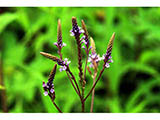
Biennial plant. Attracts butterflies and is a host for the common buckeye.
Simpler’s-joy or blue verbena is a 2-5 ft., stout-stemmed perennial with numerous, pencil-like flower spikes branched upwards like the arms of a candelabra. Each flower spike has a ring of blue-purple flowers; the flowers at the bottom of the spike bloom first, and the ring of flowers appears to advance upward to the tips of the spike. Stiff, pencil-like spikes of numerous small, tubular, blue-violet flowers are at the top of a square, grooved stem and its branches. An attractive perennial, it has flowers on showy candelabra-like spikes. Bumblebees are among the important pollinators. In ancient times the plant was thought to be a cure-all among medicinal plants and the genus name is Latin for sacred plant. Hoary Vervain (V. stricta), to 10 feet (3 m) tall and with flowers 1/2-inch (1.3 cm) long, is most abundant in the Midwest and occurs sporadically eastward. Narrow-leaved Vervain (V. simplex), has narrow leaves and lavender flowers 1/3 of an inch (8 mm) long; it is a southwestern and midwestern species.
This species is a member of the verbena family (family Verbenaceae), which includes about 75 genera and 3,000 species of herbs, shrubs, and trees, mostly of tropical and warm temperate regions. Among them, teak is a highly prized furniture wood, and Vervain, Lantana, Lippia or Frog Fruit, and Chase Tree or Vitex are grown as ornamentals.
More from USDA Plants Database »